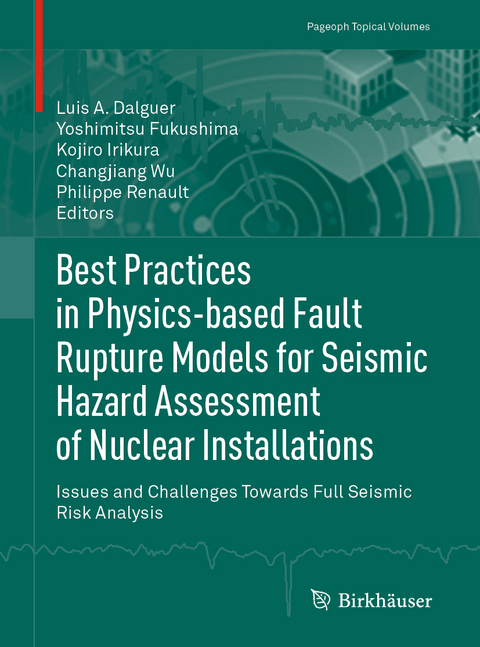
Best Practices in Physics-based Fault Rupture Models for Seismic Hazard Assessment of Nuclear Installations
Springer International Publishing (Verlag)
978-3-030-65512-9 (ISBN)
Introduction.- Computational Tools for Relaxing the Fault Segmentation in Probabilistic Seismic Hazard Modelling in Complex Fault Systems.- Testing Fault Models in Intraplate Settings: A Potential for Challenging the Seismic Hazard Assessment Inputs and Hypothesis.- Gutenberg-Richter's b Value and Earthquake Asperity Models.- Eigenoscillations and Stability of Rocking Stones: The Case Study of ''The Hus Pulpit'' in The Central Bohemian Pluton.- Scaling Relationships of Source Parameters of Inland Crustal Earthquakes in Tectonically Active Regions.- Imaging of Seismogenic Asperities of the 2016 ML 6.0 Amatrice, Central Italy, Earthquake Through Dynamic Rupture Simulations.- Sensitivity of High-Frequency Ground Motion to Kinematic Source Parameters.- Large Stress Release During Normal-Faulting Earthquakes in Western Turkey Supported by Broadband Ground Motion Simulations.- Development of Dynamic Asperity Models to Predict Surface Fault Displacement Caused by Earthquakes.- Probabilistic Evaluation of Off-Fault Displacements of the 2016 Kumamoto Earthquake.- Extension of Characterized Source Model for Long-Period Ground Motions in Near-Fault Area.- Are the Standard VS-Kappa Host-to-Target Adjustments the Only Way to Get Consistent Hard-Rock Ground Motion Prediction?- The Interface Between Empirical and Simulation-Based Ground-Motion Models.- Ground Motion Characterization for Vertical Ground Motions in Turkey-Part 1: V/H Ratio Ground Motion Models.- Ground Motion Characterization for Vertical Ground Motions in Turkey-Part 2: Vertical Ground Motion Models and the Final Logic Tree.- Numerical Simulation of M9 Megathrust Earthquakes in the Cascadia Subduction Zone.- Dynamic Source Model for the 2011 Tohoku Earthquake in a Wide Period Range Combining Slip Reactivation with the Short-Period Ground Motion Generation Process.- Earthquake Cycle Modelling of Multi-segmented Faults: DynamicRupture and Ground Motion Simulation of the 1992 Mw 7.3 Landers Earthquake.- Hybrid Broadband Seismograms for Seismic Shaking Scenarios: An Application to the Po Plain Sedimentary Basin (Northern Italy).- Kinematic Rupture Modeling of Ground Motion from the M7 Kumamoto, Japan Earthquake.- Near-Source Strong Pulses During Two Large MJMA 6.5 and MJMA 7.3 Events in the 2016 Kumamoto, Japan, Earthquakes.- Estimation of Strong Motion Generation Area for the 2004 Parkfield Earthquake Using Empirical Green's Function Method.- Optimization of a Simulation Code Coupling Extended Source (k-2 ) and Empirical Green's Functions: Application to the Case of the Middle Durance Fault.- Empirical Green's Function Simulations Toward Site-Specific Ground Motion Prediction in Vietnam.- ain Achievements of the Multidisciplinary SINAPS@ Research Project: Towards an Integrated Approach to Perform Seismic Safety Analysis of Nuclear Facilities.- Broadband Ground Motion Simulation Within the City of Duzce (Turkey) and Building Response Simulation.- Seismic Fragility Curve Assessment Based on Synthetic Ground Motions with Conditional Spectra.- Influence of Input Motion's Control Point Location in Nonlinear SSI Analysis of Equipment Seismic Fragilities: Case Study on the Kashiwazaki-Kariwa NPP.- Should We Go Ahead with the Response Spectrum?
| Erscheinungsdatum | 26.01.2021 |
|---|---|
| Reihe/Serie | Pageoph Topical Volumes |
| Zusatzinfo | VII, 586 p. 1 illus. |
| Verlagsort | Cham |
| Sprache | englisch |
| Maße | 193 x 260 mm |
| Gewicht | 1242 g |
| Themenwelt | Mathematik / Informatik ► Mathematik ► Analysis |
| Naturwissenschaften ► Geowissenschaften ► Geologie | |
| Naturwissenschaften ► Geowissenschaften ► Geophysik | |
| Schlagworte | broadband ground motion • Dynamic and kinematic source models • Fault displacement • Fragility Curves • near-source ground motion • physics-based fault rupture models • seismic hazard assessments • Seismic risk • Seismic structural response |
| ISBN-10 | 3-030-65512-1 / 3030655121 |
| ISBN-13 | 978-3-030-65512-9 / 9783030655129 |
| Zustand | Neuware |
| Haben Sie eine Frage zum Produkt? |
aus dem Bereich


